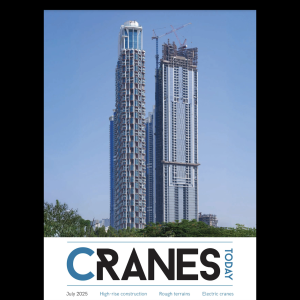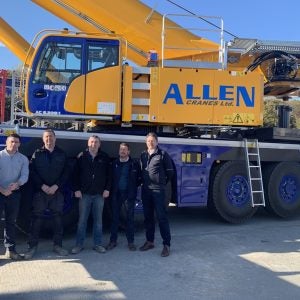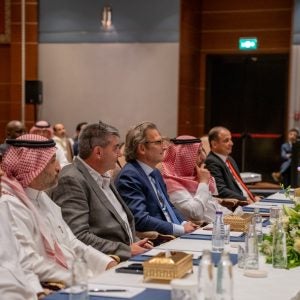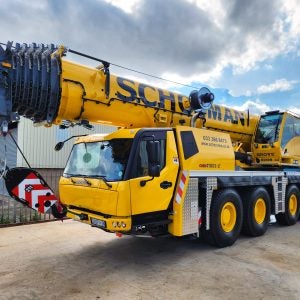The new crane aims squarely at one of the sectors where demand is still strong: building power plants. With a single rope fall, the crane will lift 20t; with three falls of rope the maximum capacity will go up to 60t, with 80t of lifting possible on four falls. The crane features a new semi-automatic system to make switching from single rope reeving, to double, to triple, easier and quicker.
The jib on the model shown at the launch was 40m, and the crane will be able to be used with a jib twice that length. The crane can be erected to a freestanding height of 90m, or can travel on rails to 75m. Using either internal or external climbing systems, the crane can raise loads to as much as 400m with two falls of rope, or 800m with a single rope.
Introducing the 1250 B, Schiefer said, “Wolffkran has had a long history. This is not the biggest crane we’ve ever made, but it is the biggest standard, serial production, luffer we’ve ever made.”
Speaking to Cranes Today after the launch ceremony, product manager Gerd Tiedke explained that it’s not just the capacty of the 1250 B that makes the crane unique: “The luffing jib hinge point is set back from the centre point, almost level with the back of the mast. This allows the jib to be safely luffed to a higher angle.
“On very tall towers, customers want cranes that can work fast. On the 1250 B, the unloaded hook can be lowered at 120m/min.
“The luffing system is optimised for the load the crane is lifting. When you’re working with a lower load, the 1250 B can luff up to 40% faster. The hoisting system is similarly optimised, to get the best possible speed, based on what rope layer you are on and what load you are lifting.
“We’re aiming to make the crane simple and easy to use. We’ve had problems in the past where operators have forgotten to select the right gear for the load they are lifting, and thought the crane had a fault. The new electronic system, like automatic transmission on a car, means you don’t need to select gears.”
The 1250 B is designed to be as quick and convenient to assemble as it is to use. Tiedke said, “The upper structure can be erected in one or two days. The counterjib tower folds in two, and the tension beams come in two sections. This means the A-frame at the rear of the crane can be carried in a single container, and easily reassembled.
“The new counterjib was first used on the 350 B, shown at Bauma in 2007. The new design uses two lightweight beams to support the machinery platform. The 1250 B is the second crane to use the new design, but it will be used across the entire Wolffkran range over the next few years.” None of the crane’s components weigh more than 15t and all can be containerised, making components easier to transport.
Schiefer said the 1250 B already has plenty of work lined up: “The first two units of the 1250 B will go to Wilhelmshaven in the autumn, for a power plant project. We have a couple more prospects in Europe, and five-to-ten power plant projects outside Europe.”
Launching a crane this size, at a time when one of the few ready sources of project spending is investment in power generation, seems eerily prescient. The same prescience served Schiefer well when few others had grasped the scale of the present economic decline. He says, “We noticed last summer (2008) that things were going bad. The UK was the first indicator: business there fell off a cliff. We got the overall impression of a tightening market, and stepped on the brakes. We acted in the summer, three or four months ahead of the cycle. We released temporary workers in the autumn of 2008.
“Many of our competitors now have a large amount of unsold inventory in stock. We got ahead of the cycle, and now we only have one unsold crane in the factory. We’re now seeing Switzerland, Scandinavia, the Benelux region, even Germany and the Gulf region outside of Dubai, performing well. We’re able to ramp up production to meet that demand, while our competitors are still cutting capacity.
“Even in Dubai, we’re getting good rental utilisation. They had an over-reaction there in the past three to four months, but now they’re getting back on track.” Cranes Today profiled Wolffkran’s Gulf joint venture, Wolffkran Arabia, in April. Schiefer says that the company uses the same model of regional deals with strong local partners, with a strong commitment to aftersales and service, in other markets: “The pattern that we’ve developed with joint ventures like Wolffkran Arabia (co-owned by Kanoo Machinery) will be one we use around the world.
“Our philosophy is that we either need to do it ourselves, through wholly-owned subsidiaries around the world, or with AAA partners, like HTC in the UK, Streif Baulogistik in Germany, or Kanoo. We want to avoid defocusing our market strategy.
“We don’t want to have thirty or forty different dealers, but to stick to either using a couple of AAA partners or doing it ourselves. You can’t sell a premium product with a weak organisation or weak partners. You need the expertise and resources to support it.”






